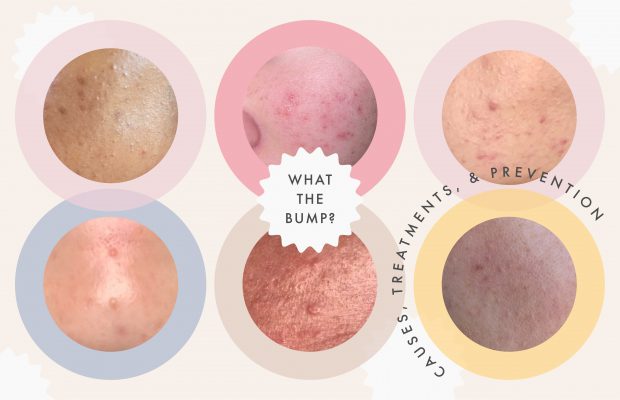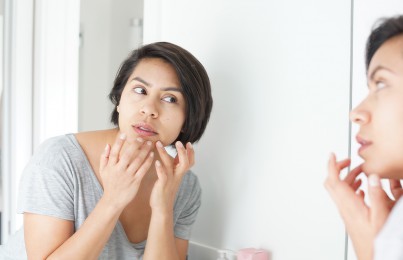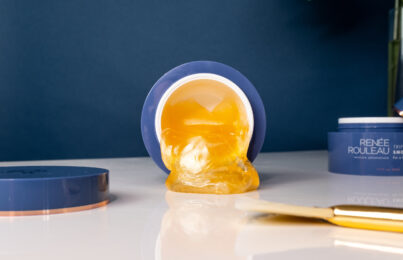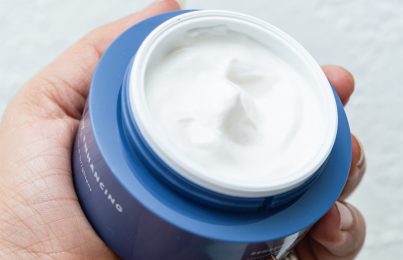Updated 10/26/21. If being an esthetician for over 30 years has taught me anything, it’s that clogged pores are a HUGE topic. Why? Because everyone thinks they have them. The reason for this is that the term “clogged pores” is thrown around a lot in the beauty industry, and it’s used to refer to all kinds of bumps and breakout-related issues. As a result, the term has become somewhat generic, and everyone has a slightly different interpretation of what it means.
Since properly identifying clogged pores is half the battle, I decided to crowdsource images from our customers and followers, asking them to send in pictures of their skin. For the sake of you, my readers, I chose six photos to assess. For each photo, I identify what’s happening and offer solutions. My hope is that you’ll be able to match your skin to what you see in the pictures, so you can learn how to address your own concerns!
I had such a fun time with this post. It was really interesting to see the different things people consider clogged pores. A big thanks to everyone who submitted pictures!
*I’ve only consulted with one of the people in this post. Everyone else’s skin I assessed based on the images they provided.
What Are Clogged Pores?
For me as an esthetician, clogged pores have a very specific definition—they’re what’s officially known as closed comedones. Closed comedones are whiteheads without any inflammation (meaning there’s no soreness or infection) that just sit under the skin. The pore becomes clogged by hardened oil and dead skin cells that fall into the pore instead of properly shedding. Together, these create a blockage, and eventually a bump.
A telltale sign of closed comedones is that they don’t go away. While red, infected blemishes tend to resolve—usually by a whitehead being pushed to the surface of the skin—closed comedones stick around. Since there isn’t an infection, your body doesn’t work as hard to get rid of it, so the pore could remain blocked for a very long time unless you get a manual extraction.
Of course, blocked pores can (and often do) lead to inflamed blemishes. This is because oxygen is unable to get inside. Without oxygen, breakout-causing bacteria, called P. acnes, can thrive. (Learn more about how breakouts form.)
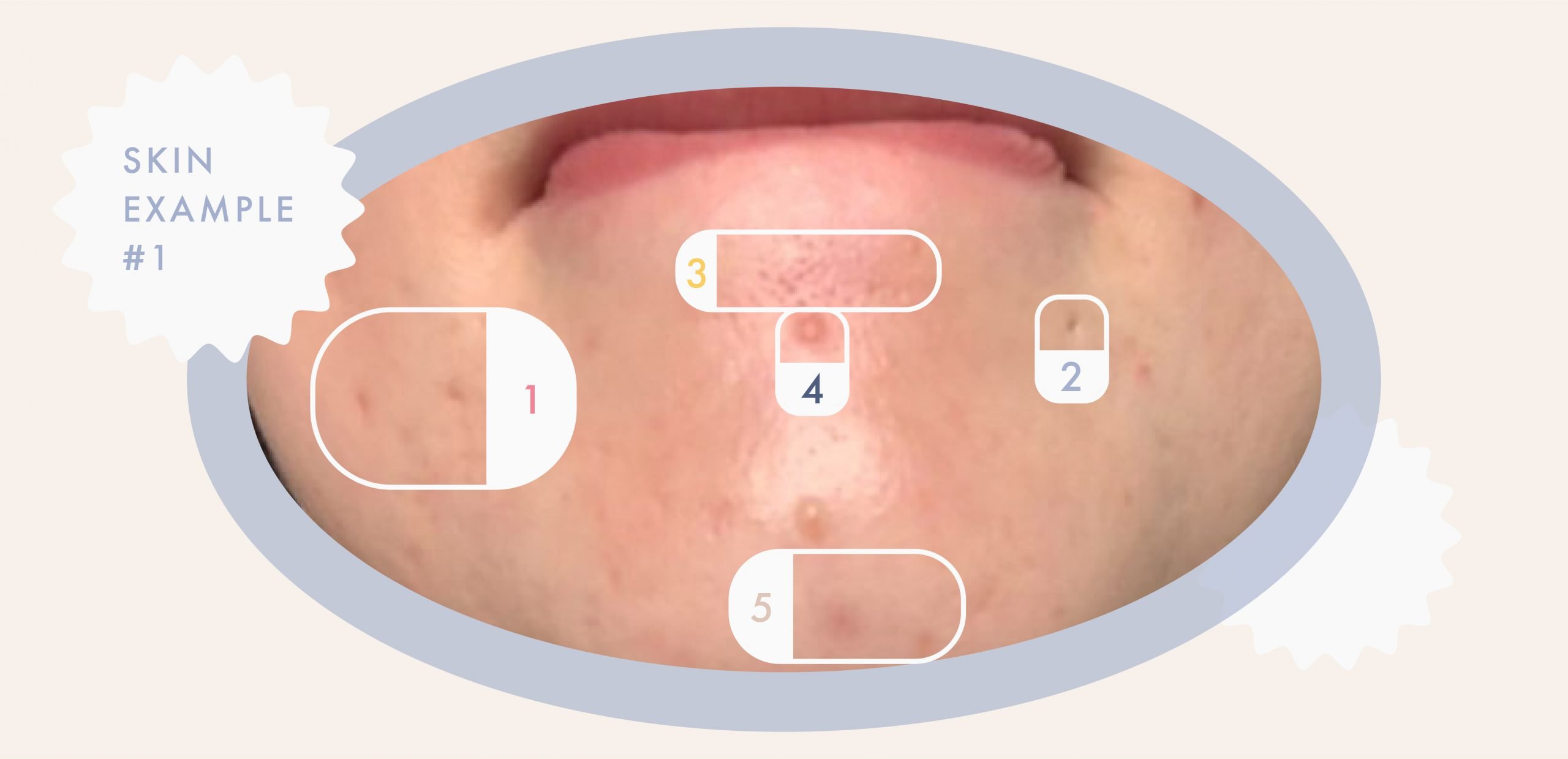
Area 1
Problem: Indented scarring from previous breakouts
Look closely inside area one, and you will see indented marks on the skin. To me, this looks like scarring left behind from either cystic or nodular blemishes (you know, those hard, painful bumps that never come to a head?). These types of blemishes occur so deep within the skin that they can cause damage to elastin and collagen fibers. Because of this, the tissue is unable to regenerate and sort of “falls in” on itself, resulting in an indentation.
Solution
Since this person looks fairly young, it’s possible that the indents can improve on their own. That said, the skin will probably never be restored to full volume without some kind of cosmetic intervention. As far as at-home solutions, I recommend using a vitamin C serum and a prescription retinoid (you’ll have to consult a dermatologist for the latter, of course). This can help boost collagen to create a smoother texture.
If at-home solutions aren’t enough, I would suggest seeking out professional treatments. Looking into one or more of the following: chemical peels, laser treatments, microneedling combined with radiofrequency, or having filler injected into the area. It’s important to consult with a dermatologist to determine which course of action is best for you!
Area 2
Problem: Enlarged pore from piercing
It looks like this is an enlarged pore from a piercing, because of the location and the perfect circle shape of the indent.
Solution
There isn’t much that can be done for this, aside from maybe filler. I always tell people to consider piercings carefully since they can create a permanently enlarged pore.
Area 3
Problem: Enlarged pores in the crevice of the chin
As you can see, the person in this picture is pulling their lip taut to reveal enlarged pores in the crevice of the chin.
Solution
A lot of my clients complain that they can see the same thing when they pull their lip taut, and my solution is pretty simple—don’t pull your lip like that! We tend to focus on what we perceive as imperfections when examining our faces in the mirror, but the reality is that’s just not something anyone else is going to see. Trust me, almost everyone has enlarged pores in this area of the face. Since there’s a natural crease in the skin, oil and debris collect here.
The best thing you can do is make sure this area is kept clean. I suggest cleansing both morning and night and wiping a toner, like the Rapid Response Detox Toner, over the area. (By the way, if you have blackheads that never go away, they could be sebaceous filaments.)
Area 4
Problem: Blemish (papule)
Once a pore becomes clogged and forms a closed comedone, a papule often forms next. This is the result of a clogged pore becoming inflamed due to infection. It usually means it’s on its way to becoming a full-fledged pimple, complete with a surface whitehead that can eventually be extracted. This final stage is known as a pustule, aka, a good ol’ zit.
Solution
At this point, I would apply a non-drying spot treatment like Anti Bump Solution. Once the papule turns into a pustule and is ready to be extracted, it can be gently squeezed out. Only then should you apply a drying spot treatment to knock out any infection that’s left lingering in the pore. (Read more about spot treatments and when to use them.)
Area 5
Problem: Post-breakout marks
As the last step in the life cycle of a blemish, we have post-breakout marks. You can see a cluster of them on this person’s chin from past blemishes that have left discoloration behind.
Solution
There are two cornerstones of fading post-breakout marks—exfoliation and sunscreen. Make sure you’re exfoliating regularly and you’re applying a generous amount of SPF to your skin every single day. Of course, you’d ideally like to prevent breakouts so they can’t leave a mark behind in the first place. It’s easier said than done, I know!
Breakouts on the chin and jawline are really common—especially for women—and are often hormonally driven. (Here are my best tips for preventing annoying chin and jawline breakouts.)
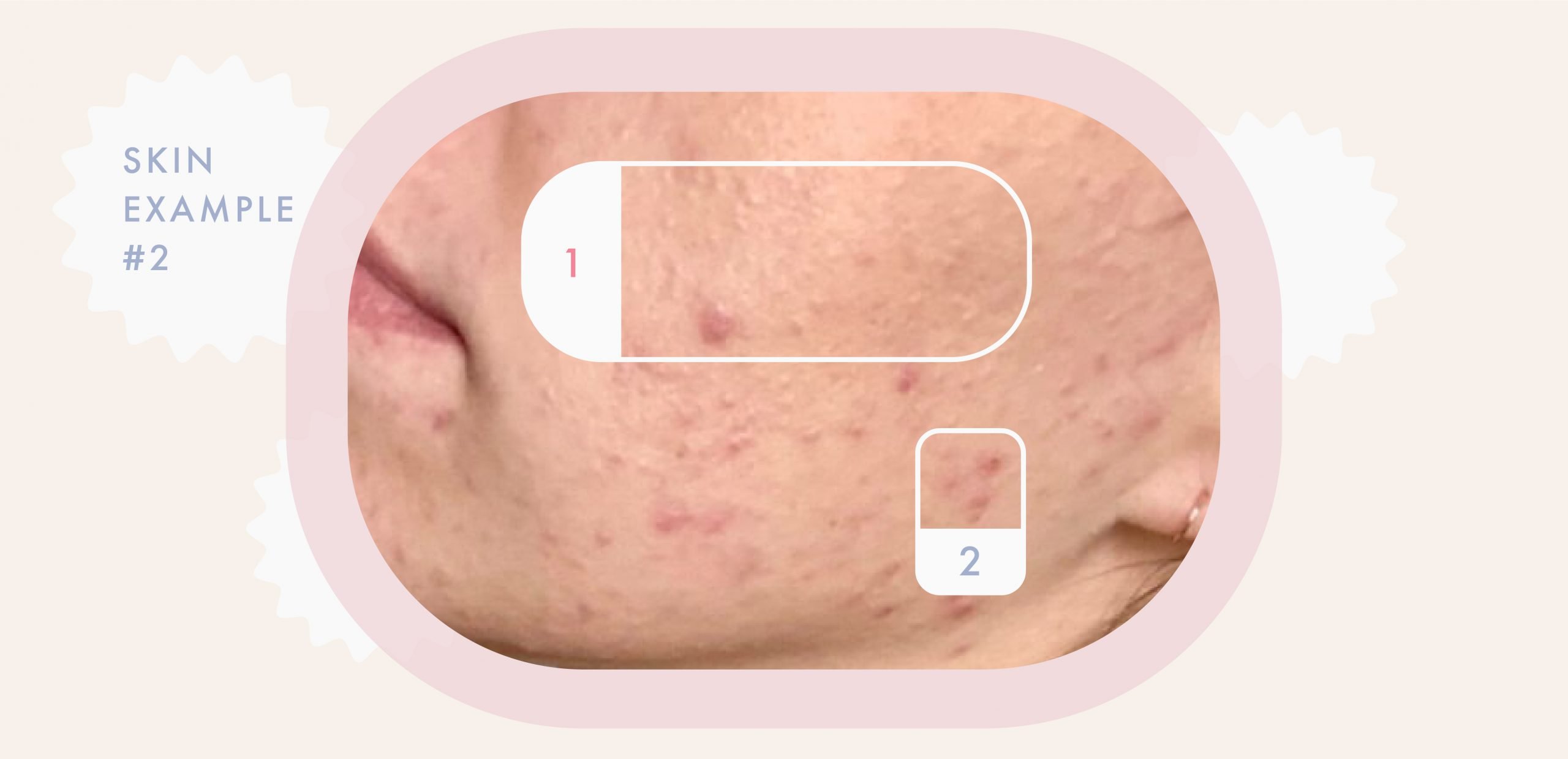
Area 1
Problem: Clogged pores (closed comedones)
I consider these raised bumps (the white ones, not the red ones) to be true clogged pores. You can see that this person’s skin is congested because they have these white-ish, non-infected bumps, also known as closed comedones, all over.
Solution
I would give these tips to a person who wants to get rid of skin congestion and clogged pores:
- Cleanse well. Keep your skin clean by washing your face both morning and night. Make sure to properly remove makeup and sunscreen by wiping your skin with a gentle washcloth after cleansing.
- Exfoliate often. Regular exfoliation is important for everyone, but especially if you have clogged pores. Part of what causes clogged pores to form is the irregular shedding of dead skin cells. Since they’re not being shed normally, they fall into pores and build up. This disrupts the healthy flow of oil. So, exfoliating, particularly with a chemical exfoliant a few times a week, can help correct this by clearing a pathway for the blockage to come to the surface. Pair a chemical exfoliant, like the Renée Rouleau Pore + Wrinkle Perfecting Serum, with a gentle physical scrub once or twice a week to lift dead cells off of the skin.
- Hydrate with water-based products. This one may seem counterintuitive, but keeping the skin properly hydrated is of the utmost importance. Skin cells are like fish in that they need water to live. Dehydrated skin cells die off more quickly. This leads to an increase in dead skin cells on the surface of the skin. If they aren’t properly shed, that means there are more dead skin cells that can build up in the pores. Use a lightweight moisturizer to provide the skin with plenty of water. Avoid heavy creams. (Make sure you know the difference between dry and dehydrated skin.)
- Avoid drying products. Speaking of dehydration, breakout-focused products are notorious for causing it! Again, it might seem counterintuitive, but I recommend avoiding harsh or drying products that could cause more clogged pores in the long run by exacerbating surface dryness.
- Be wary of heavy makeup. While I believe wearing makeup is actually good for the skin, I would avoid wearing heavy, long-wear foundation, cream blushes, and primers. In my experience, these types of products can often cause congestion in the skin. Here’s a list of foundations for oily, breakout-prone skin.
- Get extractions. Depending on the number of clogged pores you’re dealing with, I recommend seeing an esthetician for professional extractions once a week for maybe 1-2 months. I know this sounds like a lot but it can be so helpful for clearing clogged pores. Skincare products can only get you so far. In many cases, a clogged pore must be manually removed. This isn’t something you want to do yourself since extractions, when done incorrectly, can damage the skin.
- Get a chemical peel. Over time, a series of professional-grade chemical peels can help clear pores.
My final piece of advice is to be patient. This person didn’t get all of their clogged pores overnight, and they won’t get rid of them overnight, either. Clearing congestion requires patience and consistency, and it may take up to a few months to see real results. The good news is that once pores are clear, it’s much easier to keep them that way! (Read all about how to keep your pores clean.)
Area 2
Problem: Blemishes (papules and pustules)
While this person doesn’t have a lot of inflammation in their skin, it looks like some of their clogged pores have turned into infected blemishes.
Solution
Check out my 17 tips that just might banish your breakouts for good.

Area 1
Problem: Blackheads
Blackheads are technically a type of clogged pore. Instead of closed comedones, they’re what’s known as open comedones. Instead of being trapped under the surface of the skin, the gunk inside the pore is exposed to air, which causes it to oxidize and turn black (or sometimes more of a grey-ish color).
Solution
Blackheads are a concern for so many people, and I always tell my clients that it’s normal to have them to an extent. The ones pictured here, however, are quite large and could easily be extracted by an esthetician following the proper protocol. If you can’t make it to see an esthetician, here’s how to safely extract blackheads.
Area 2
Problem: Milia
Milia occurs when keratin gets trapped under the surface of the skin. These bumps are usually more perfectly rounded than closed comedones (they’re sometimes described as little “pearls”) and are often more off-white in color. It’s common to see milia around the eyes, like in this picture, but they can also crop up around the nose or on the cheeks. Why do milia occur? It’s hard to pinpoint, but a common cause is a too-greasy eye cream. Sometimes it’s simply genetics.
Solution
Don’t squeeze milia on your own. The skin over the bump is hard and picking it will just damage the skin. Milia need to be removed by a professional, either a cosmetic dermatologist or a qualified esthetician. Once removed, milia usually won’t come back in that same pore.
Area 3
Problem: Dehydration
To me, this looks like a classic case of dehydration. (See what dehydrated skin looks like.) It’s probably caused by using drying, breakout-focused products in an attempt to clear blemishes and clogged pores.
Solution
It’s so important to maintain healthy water levels in the skin by using a moisturizer formulated for your skin type and not overdoing it with harsh, drying products. (Find out how I fix dryness caused by overly-drying breakout-focused products.)
Area 4
Problem: Blemish (pustular)
This looks like a classic blemish caused by an impacted blackhead based on the fact that I can still see an opening in the skin.
Solution
Extraction is necessary for this blackhead.
Area 5
Problem: Post-breakout marks
Since there are no bumps in this area, this seems to be a group of post-breakout marks leftover from past blemishes.
Solution
I would recommend the same course of action I describe in the first example. Again, exfoliation and sun protection is key!
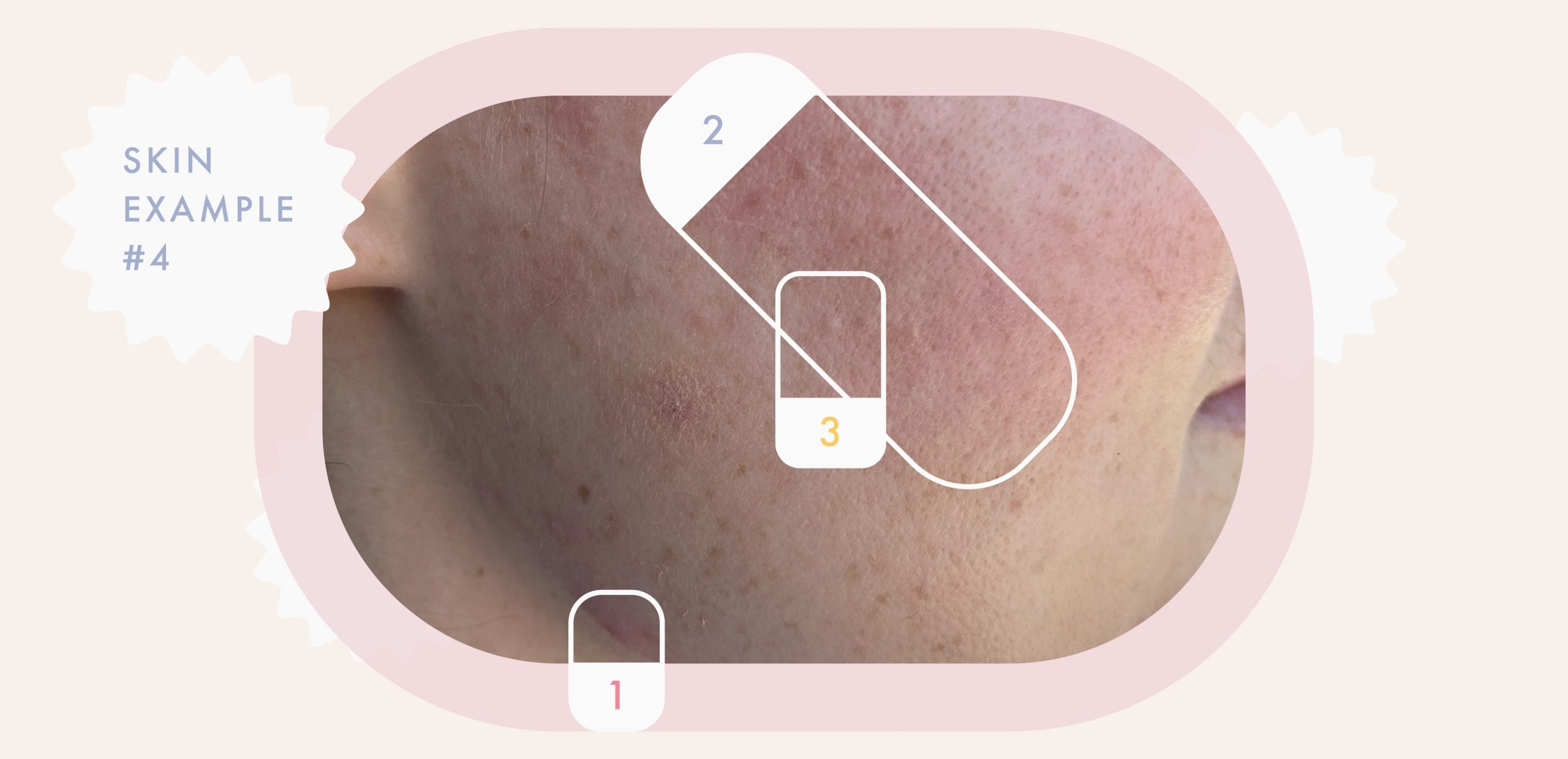
Area 1
Problem: Cystic breakout
It’s a bit difficult to see from this picture, but I can tell this person has a stubborn cystic breakout here on their jawline. Again, the chin and jawline are common places to experience cystic acne, especially for women.
Solution
There are a couple of things I suggest for cystic blemishes. The first is to avoid picking at them—seriously, don’t pick! They occur deep within the skin and are meant to be reabsorbed as opposed to coming to a head. Second, apply a non-drying spot treatment like the Renée Rouleau Anti Bump Solution. Third, try limiting dairy consumption. Dairy is a common trigger for many people who struggle with cystic blemishes.
Area 2
Problem: Inflammation (redness)
In this area, you can see some redness and flushing. This redness stands in pretty sharp contrast to the rest of the skin. To me, this signals that there’s some stagnation in the skin, meaning circulation isn’t great and things aren’t being filtered out as well as they should be. This could potentially be linked to the gut microbiome or something else internal, so I would recommend seeing a nutritionist or holistic doctor who can advise on this, as the link between the microbiome and inflammatory conditions of the skin is being studied now more than ever. I would also recommend seeing a dermatologist or physician to make sure there’s no underlying disorder of the skin.
Solution
In the meantime, I would recommend that this person try one of my favorite tricks. Every night, hang your head upside down for three minutes to bring blood flow to the face and increase circulation. I do this faithfully for glowing skin.
Area 3
Problem: Clogged pores (closed comedones)
These are classic closed comedones.
Solution
I would suggest the same course of action I recommended in the second example. Exfoliate regularly, keep the skin hydrated with water-based products, and seek out professional extractions from a trained esthetician. In addition, I would advise against using any kind of retinol or retinoid at this point. Retinol can cause a certain level of inflammation and since this person is already experiencing visible inflammation, we don’t want to add fuel to the fire. Instead, they should focus on using products with calming ingredients. (Based on all of this, I would say this person is a skin type #5. Find your skin type now!)
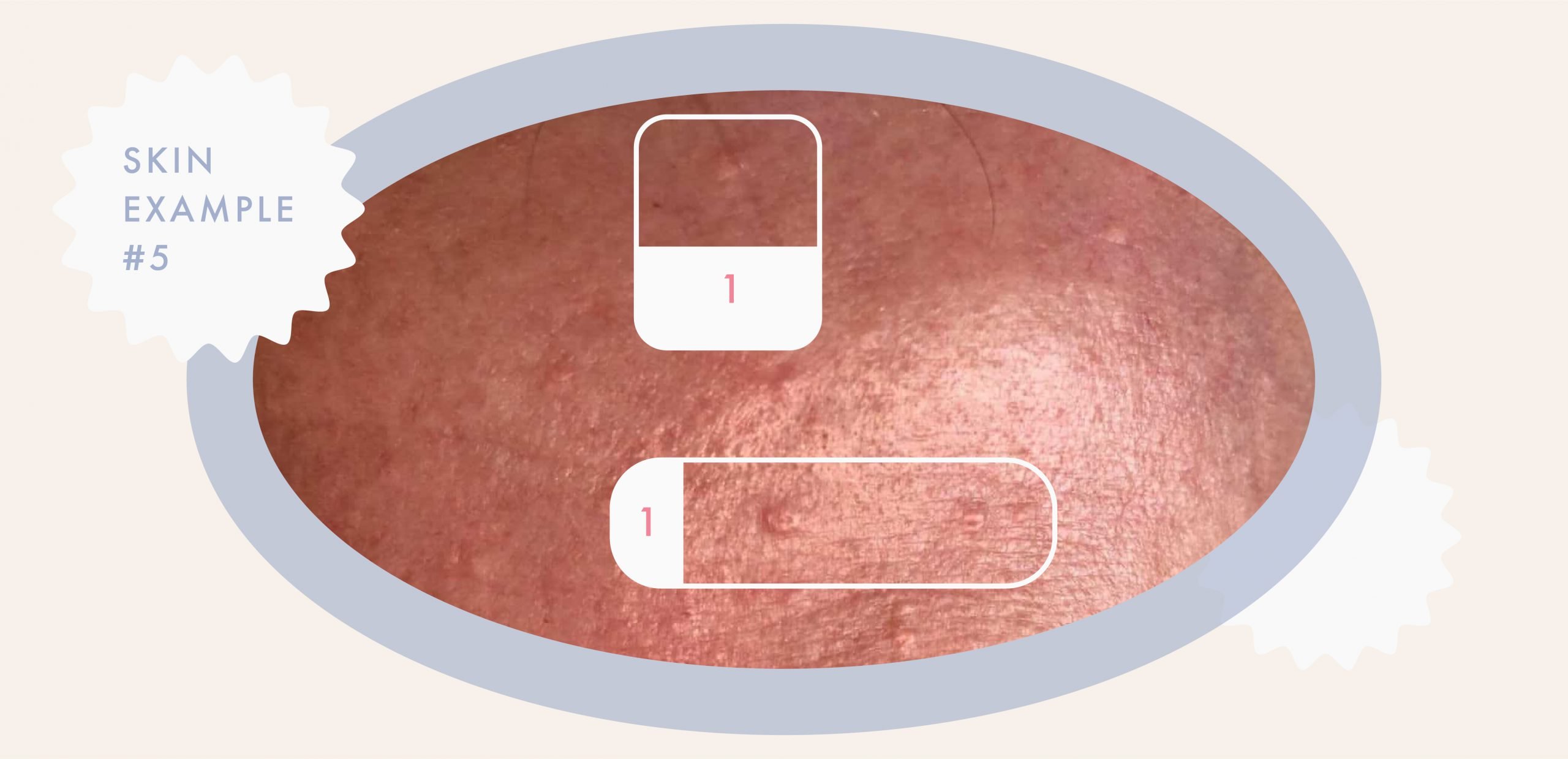
Area 1
Problem: Skin growths
This person is a client of mine from years ago who had gone to see a dermatologist about these bumps on their forehead. The dermatologist diagnosed them as sebaceous hyperplasia (a common and benign skin growth). These can be mistaken for clogged pores since they may appear as white bumps, especially in those with lighter skin tones. However, sebaceous hyperplasia tends to look longer and flatter than closed comedones. There are a few things that can cause them, but thickened skin from sun exposure is one of the most common reasons, and I think that’s exactly what has happened here.
Solution
To have these removed, you would need to see a dermatologist. You definitely don’t want to squeeze these! They’ll typically use either electric cauterization or cryotherapy. (Learn more about different types of bumps on the skin and how to get rid of them.)

This last skin assessment is for Gayle, a customer who won a virtual consultation as part of an Instagram giveaway! So, in addition to examining the photos she sent, I was able to talk with her a bit about what was causing some of her concerns.
Area 1
Problem: Post-breakout marks
Like many of the people whose skin I’ve assessed in this post, Gayle has some post-breakout marks. To me, it looks like she was trying to do some extractions or squeeze at her breakouts. One thing to be mindful of is that darker skin tones are more prone to discoloration and it usually takes longer to fade. Since there is naturally more pigment in the skin, any trauma or injury that causes inflammation will easily send pigment cells into overdrive.
Solution
The protocol for removing discoloration is the same as the protocol for removing post-breakout marks. Exfoliate with a combination of chemical and physical exfoliants and protect with vitamin C and sunscreen during the day. If you have a darker skin tone and are prone to dark marks, the key is preventing injury to the skin as much as possible (so don’t squeeze or pick!). While they’re inevitable to an extent if you’re prone to clogged pores and breakouts, you DO have control over how you manage a breakout once it appears. I always encourage my clients to address their breakouts in a way that works in harmony with their body’s natural healing process to cause the least amount of damage possible. (Read how to get rid of a blemish, fast.)
Area 2
Problem: Clogged pores (surface-level closed comedones)
While you can see that I’ve circled clogged pores in both areas two and three, the difference between them is that these are very close to the surface and appear ready to come out. You can see more of a whitehead—they’re what I like to call “ripe.”
Solution
Since these non-infected clogged pores are ready to come out, I suggest using a sterile lancet to pierce the whitehead before very gently extracting it from the skin. While it’s ideal to go to a professional for extractions, the reason I think it’s okay to self-extract these is that they should come out very easily, meaning they won’t cause damage or leave discoloration behind. Using a lancet is helpful because it creates an opening for the blockage to come out, so you shouldn’t have to squeeze very hard at all.
Area 3
Problem: Clogged pores (deeper closed comedones)
These clogged pores aren’t close to the skin’s surface.
Solution
- Find a trusted professional. Since they’re not at the surface of the skin, I would not suggest Gayle try to extract them herself. She should either see an esthetician or wait until they’ve come to the surface like the ones near her cheek.
- Use makeup for your skin type. She did mention to me that she uses a lot of heavy foundation and cream blush, so much like the person in the second example, I would recommend she stop using these makeup products and opt for one of these foundations instead.
- Exfoliate often. Because her skin is on the oily side, she should exfoliate using BHAs (beta hydroxy acid). She needs to be careful though—a lot of BHA products can be pretty drying, and this is the last thing you want since dry skin can trap oil and bacteria, leading to more clogged pores. She needs to look for a BHA product with a gentle formulation, such as the Renée Rouleau Pore + Wrinkle Perfecting Serum.
- Use lightweight products. Finally, Gayle should make sure she’s using lightweight, water-based hydrating products. She mentioned she was using a lot of very moisturizing masks and creams, but for her skin type (she is a skin type #2), this is too much. Using something water-based will keep her skin looking glowy and even-toned without clogging her pores.
There you have it! If you came to this post looking for solutions, I hope you saw yourself in one of these photos and gained some insight. Clogged pores are a huge topic but once you get a handle on them, they’re so much easier to stay on top of in the future.
Next, do pimple patches work on all types of breakouts? Here’s what you need to know.
Celebrity Esthetician & Skincare Expert
As an esthetician trained in cosmetic chemistry, Renée Rouleau has spent 30 years researching skin, educating her audience, and building an award-winning line of products. Her hands-on experience as an esthetician and trusted skin care expert has created a real-world solution — products that are formulated for nine different types of skin so your face will get exactly what it needs to look and feel its best. Trusted by celebrities, editors, bloggers, and skincare obsessives around the globe, her vast real-world knowledge and constant research are why Marie Claire calls her “the most passionate skin practitioner we know.”
